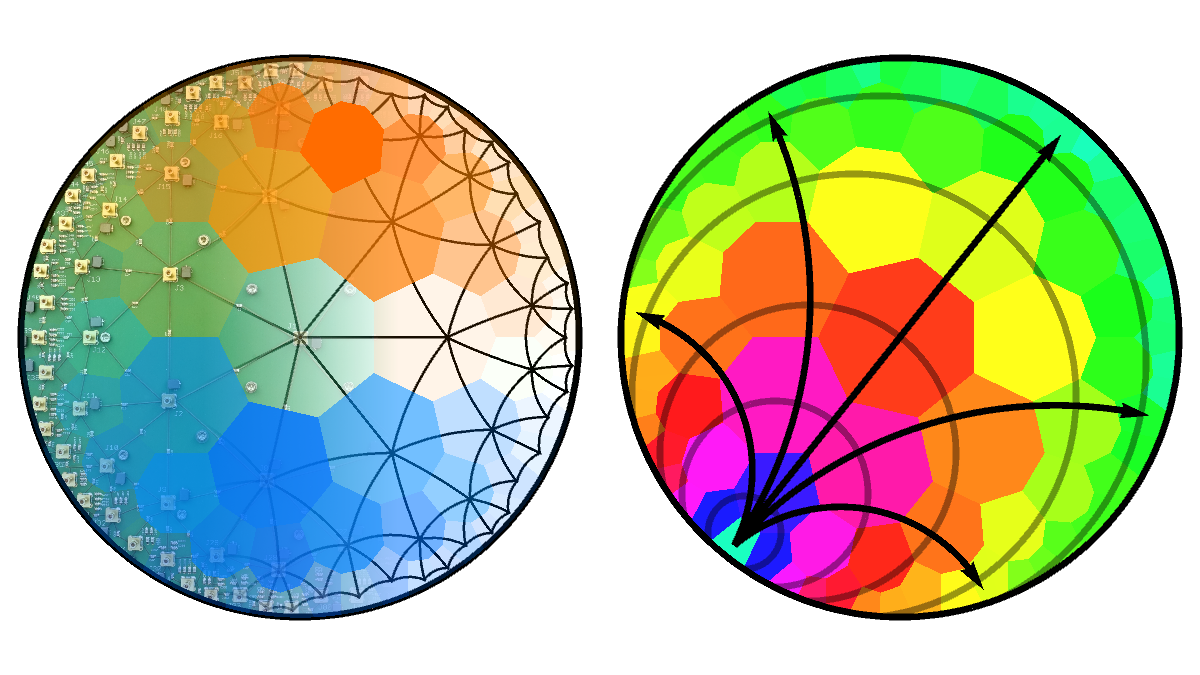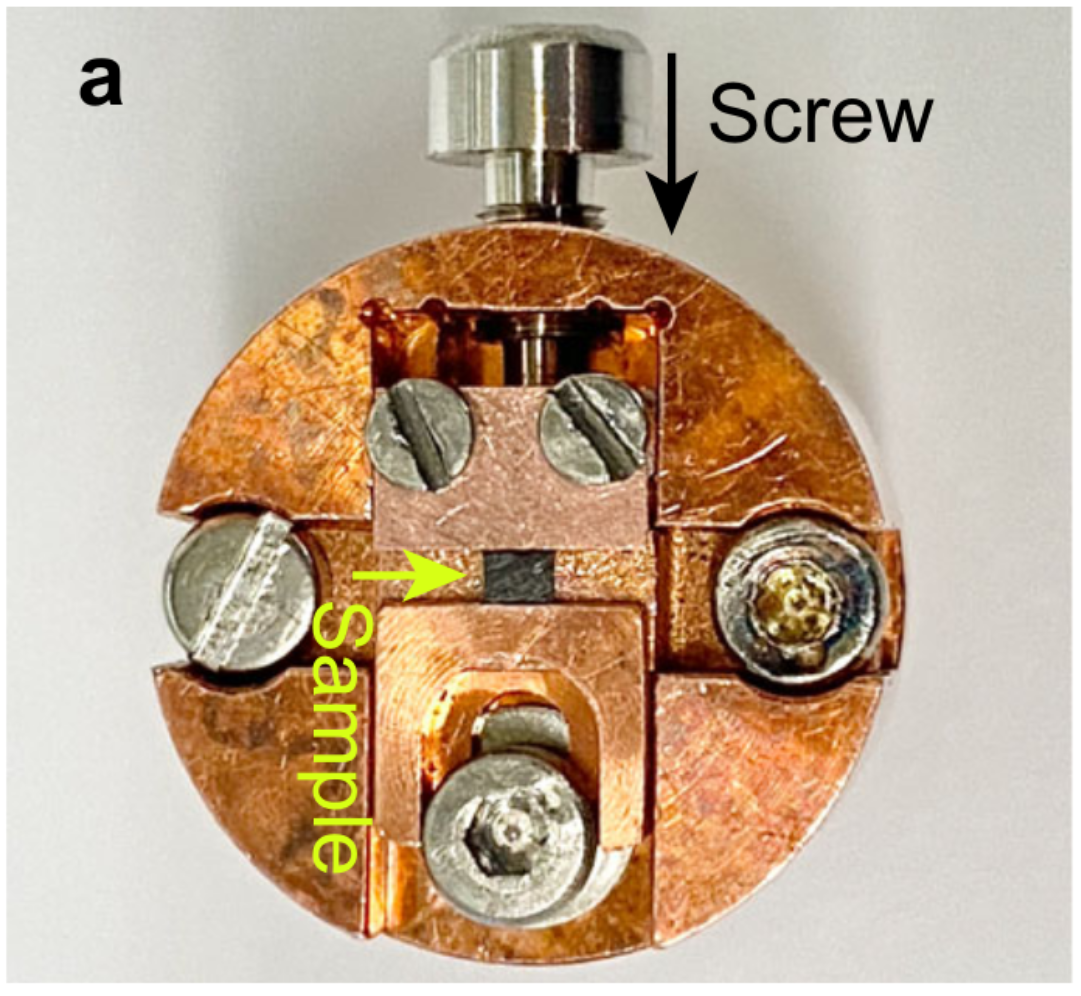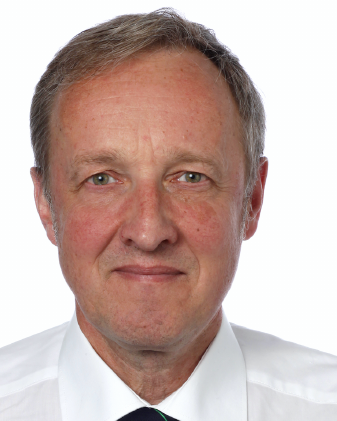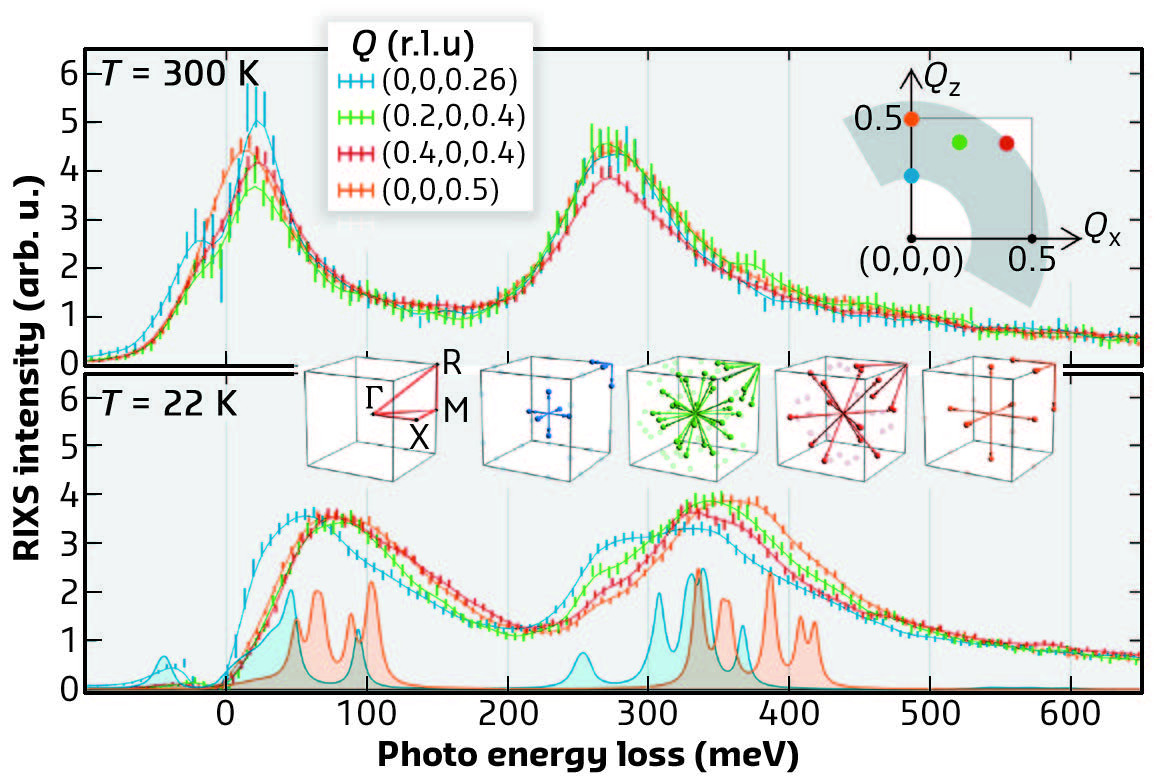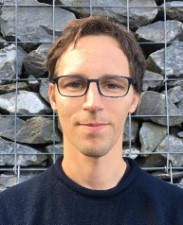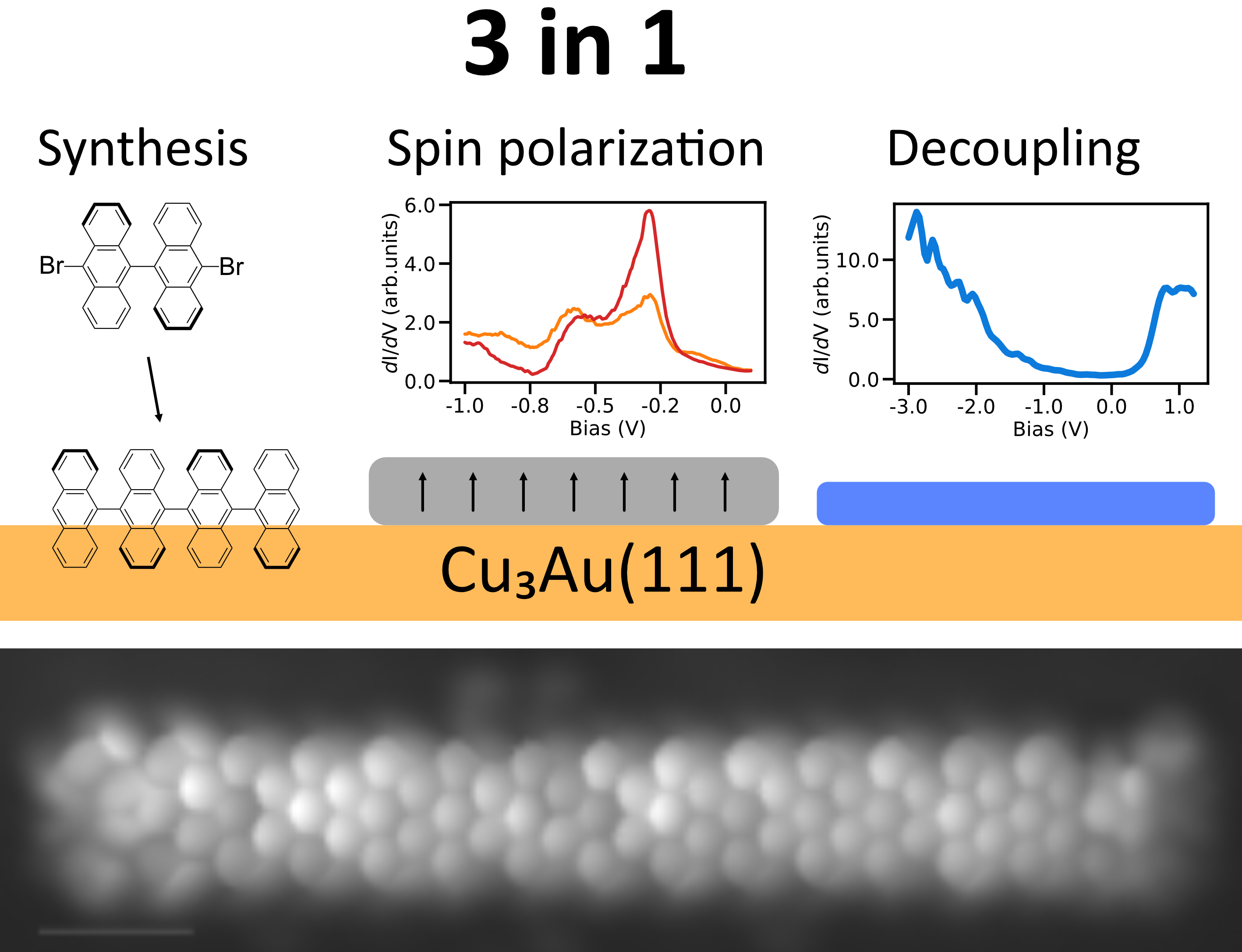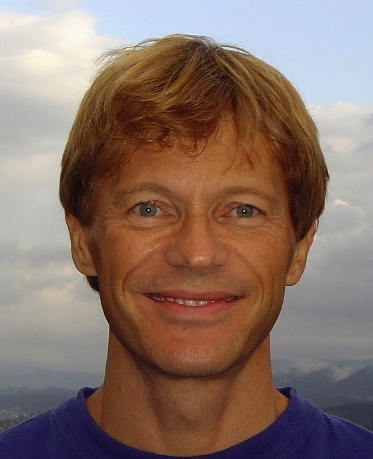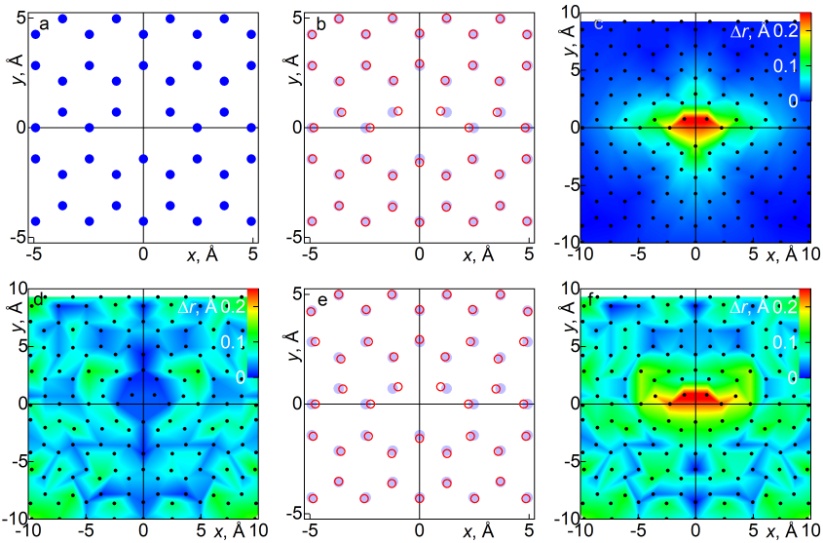Condensed Matter Physics
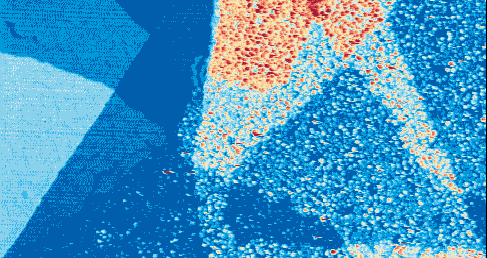
Table of contents
- Prof. Titus Neupert - Condensed matter theory
- Prof. Johan Chang - Superconductivity and Magnetism
- Prof. Marta Gibert - Oxide Interface Physics
- Prof. Thomas Greber - Low dimensional systems
- Prof. Marc Janoschek - Correlated Quantum Matter
- Prof. Fabian Natterer - Quantum Matter
- Prof. Andreas Schilling - Phase Transitions, Materials and Applications
- PD. Tatiana Latychevskaia (PSI) - Coherent Diffraction Imaging
Prof. Titus Neupert - Condensed matter theory
We study topological phases of quantum matter with numerical and analytical tools. Topological electronic states are characterized universal and robust phenomena, such as the Hall conductivity in the integer quantum Hall effect, that are of fundamental interest or promise applications in future electronics. We study and propose concrete materials to realize such topological effects, but are also interested in studying abstract models to understand what phases of matter can exist in principle.
Our numerical toolbox includes neural network algorithms to study strongly interacting quantum many-body systems. Furthermore, we work at the interface of quantum computing and condensed matter physics.
Hyperbolic space in the lab
General relativity teaches us that curved spaces are a reality. In condensed matter physics this insight is of little consequence as the scales of gravitation and electrodynamics are too different. Yet, curved spaces make an appearance in other forms — for instance to solve strongly interacting conformal field theories via their holographic correspondence with anti de-Sitter spaces or when compactifying condensed matter models into a finite curved system such as a sphere. However, little is known about how the curvature of space affects common concepts in condensed matter physics, such as band structures of crystal lattices, symmetry breaking phases or topological order.
The condensed matter theory group committed to shed light on these questions through a series of projects, led in particular by Tomas Bzdus̆ek and Patrick Lenggenhager. The specific subject of study were lattice discretizations of homogeneous two-dimensional hyperbolic space, i.e., a sheet with constant negative curvature. In contrast to the positive curvature cousin, the sphere, this space is infinite and cannot be embedded in three-dimensional space, i.e., our observable world. This fact impedes experimental studies of hyperbolic lattices — almost! In a fruitful collaboration with the electronic workshop of the Department of Physics and the group of Ronny Thomale at Ludwig-Maximilians Universität Würzburg, the researchers were able to realize and measure a hyperbolic lattice on a circuit board, where nodes are coupled by capacitors and inductors. The unique opportunity that electric circuits offer is a decoupling between the physical distance of two nodes and the strength with which they interact. The latter is solely determined by the characteristics of the circuit element that connects them. This way, a Poincaré projection of hyperbolic lattice with about one hundred nodes could be mapped on a circuit board. The eigenmodes of the circuit were measured experimentally. They are in some sense analogous to the vibration modes of a “hyperbolic drum”, which are distinctly reordered compared to the Euclidean case as a result of the negative curvature. Furthermore, the project studied the wave propagation on the hyperbolic lattice, which follows the curved-space geodesics.
Figure: Left: Overlay of the hyperbolic lattice electrical circuit and a measurement of one of its lowest eigenmodes. Right: Measurement of a wave packet propagating on the hyperbolic lattice, showing the curved geodesics.
Another project of purely theoretical nature proposed a way to construct topological band structures in hyperbolic space. This was the master thesis of David Urwyler, who received the first edition of the Soluyanov Prize for the best theoretical master thesis for his work for his thesis. Meanwhile the exploration of other aspects of hyperbolic quantum matter is ongoing.
Highlighted Publications:
1. Simulating hyperbolic space on a circuit board, P. M. Lenggenhager et al., Nature Communications 13, 4373 (2022)
2. Hyperbolic Topological Band Insulators, D. M. Urwyler et al.Phys. Rev. Lett. 129, 246402 (2022)
3. Hyperbolic Matter in Electrical Circuits with Tunable Complex Phases, A. Chen et al. arXiv:2205.0510, Nat. Commun. 14, 622 (2023)
Prof. Johan Chang - Superconductivity and Magnetism
We investigate quantum matter phases emerging from strong electronic interactions. High-temperature superconductivity, strange metals, density-wave instabilities and electronic driven metal-insulator transitions are studied by synchrotron and laboratory based experimental techniques. At international synchrotrons, we are carrying out angle-resolved photo-emission spectroscopy (ARPES) and resonant inelastic x-ray scattering (RIXS) to reveal electronic structures and properties of correlated electron systems. Quantum phase transitions tuned by magnetic field or hydrostatic pressure are furthermore explored by high-energy x-ray diffraction. Within our laboratory, similar themes are probed by electrical and thermo-electrical transport measurements. Our group also has technical initiatives to develop innovative and compact cryo-cooling methodology. Finally, we are involved in data science analysing x-ray scattering results using machine learning methodology.
A hallmark of quantum matter is complex phase diagrams reflecting numerous broken symmetries. Strikingly, despite distinct underlying microscopic interactions, phase diagrams are remarkably similar across a large range of material classes. For example, unconventional superconductivity is often found in the vicinity of magnetic quantum critical points around which competing electronic phases emerge. Their respective broken symmetries are often subtle and difficult to reveal experimentally. The difficulty stems from the challenge to lift electronic domain degeneration.
To make progress our team designed and produced withour in house workshop uniaxial pressure cells for x-ray diffraction. Difference designs were developed for respectively resonant (see Figure) and non-resonant x-ray diffraction. It let us to solve a long standing problem about the symmetry of charge stripe order in high temperature cuprate superconductors.
Figure: Custom sample holder for the application of uniaxial pressure.
Charge stripe order proven
We investigated the charge order in La1.88 Sr0.12 CuO4 via x-ray diffraction with uniaxial pressure as a domain-selective stimulus to establish the unidirectional nature of the CDW unambiguously. A fivefold enhancement of the CDW amplitude is found when homogeneous superconductivity is partially suppressed by magnetic field. This field-induced state provides an ideal search environment for a putative pair-density-wave state.
Inducing a stripe order rotation
From a strong-coupling perspective, transverse stripe fluctuations are realized in the form of dynamic “kinks”—sideways shifting stripe sections. In recent work, we show how modest uniaxial pressure tuning reorganizes directional kink alignment. We find that in La1.88 Sr0.12 CuO4 transverse kink ordering results in a rotation of stripe order away from the crystal axis. Application of mild uniaxial pressure changes the ordering pattern and pins the stripe order to the crystal axis. This reordering occurs at a much weaker pressure than that to detwin the stripe domains and suggests a rather weak transverse stripe stiffness. Weak spatial stiffness and transverse quantum fluctuations are likely key prerequisites for stripes to coexist with superconductivity.
Highlighted Publications:
1. Unveiling Unequivocal Charge Stripe Order in a Prototypical Cuprate Superconductor, J. Choi et al., Physical Review Letters 128, 207002 (2022)
2. Uniaxial pressure induced stripe order rotation in La1.88 Sr0.12 CuO4 , Q. Wang et al., Nature Communications 13, 1795 (2022)
3. Crystal symmetry of stripe-ordered La1.88 Sr0.12 CuO4 ,R. Frison et al., Physical Review B 105, 224113 (2022)
Prof. Marta Gibert - Oxide Interface Physics
In our group, we grow transition metal oxide heterostructures (i.e. thin films, superlattices) and we investigate their functionalities. We especially focus on the study of the electronic and magnetic properties resulting from reduced dimensionalities and reconstructions occurring at oxide interfaces. Our goal is to understand the subtle atomic-scale structural and electronic mechanisms controlling interface physics in complex oxides. This knowledge is key for the rational design of materials with tailored properties. The atomic-scale precise oxide layers are grown by off-axis rf magnetron sputtering.
Transition metal oxides are a fascinating and widely studied class of materials displaying a broad spectrum of physical properties (i.e. metal-insulator transitions, magnetism, superconductivity, etc.), which makes them highly attractive candidates for next-generation electronic devices. All these functionalities stem from strong electronic correlations and a complex interplay between the charge, orbital, spin and lattice degrees of freedom. Furthermore, the possibility of creating thin films and heterostructures, thus imposing strain and low dimensionality, allows these functionalities to be tuned even more and meta-stable phases to be stabilized. The investigation of these types of materials has already proven to be successful. As an example, we recently showed that nickelate films as thin as 2 u.c. (0.8nm) are still ferromagnetic [1].
-
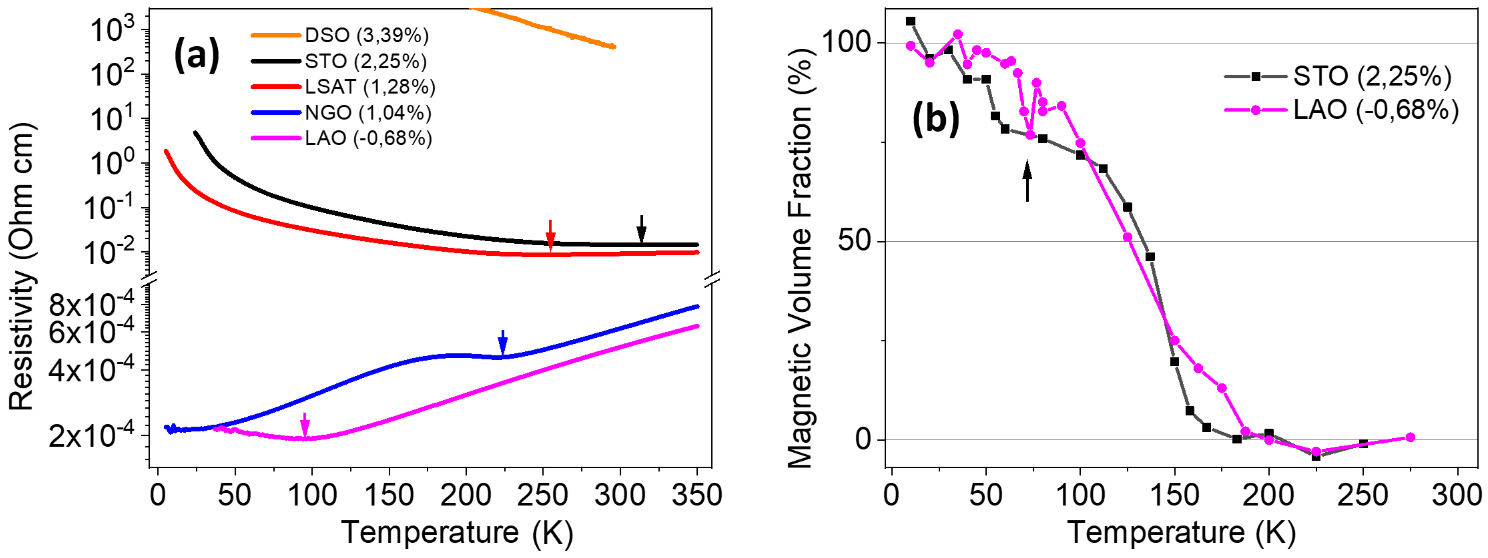
- Zoom (PNG, 130 KB)
- Figure: (a) Resistivity measurements of 25 uc (10 nm) thick SrCrO3 thin films as a function of temperature and strain. The arrows indicate an upturn in resistivity. (b) Muon spin relaxation measurements for two differently strained SCO samples. The arrow indicates a dip in magnetic volume fraction, possibly caused by a spin reorientation.
Currently, our group is studying the SrCrO3 (SCO) compound which is suggested to be an antiferromagnetic metal, an unusual combination of properties. The goal of our investigation is to grow and characterize epitaxial SCO thin films to address its debated physical properties. The difficulties in synthesising this material are explained by the need to stabilize the rare Cr+4 ionized state. Therefore, the growth of SCO thin film by RF magnetron sputtering requires a very low but finite amount of oxygen since an excess or the absence of oxygen leads to unwanted structures or poor growth quality. In order to successfully grow SCO film, the existing growth chamber has been modified to allow a very low and precise amount of oxygen (ratio Oxygen-to-Argon: 1/10000) to be injected. In this manner, high-quality SCO films were grown on a variety of substrates imposing compressive and tensile strain. Transport measurements have revealed a metallic phase down to 100K in low-strain films, whereas increasing tensile strain induces a metal-to-insulator transition. Muon spin relaxation measurements revealed a strain-independent magnetic phase at temperatures below 150K. This phase can be associated with an antiferromagnetic spin ordering as no ferromagnetism could be detected. These findings are the first indication of the coexistence of an antiferromagnetic and metallic phase on SCO films. Further magnetoresistance and Hall-effect measurements are ongoing to complete the characterization of SCO films.
Highlighted Publications:
1. Top-Layer Engineering Reshapes Charge Transfer at Polar Oxide Interfaces, G. De Luca et al., Adv. Materials 2022, 34, 2203071 (2022).
Prof. Thomas Greber - Low dimensional systems
We study objects like zero-dimensional endofullerene molecules and two-dimensional (2D) boron nitride layers in view of their functionality as nano-materials. Single-molecule magnetism is the focus of the fullerene research, where we apply x-ray absorption and a sub-Kelvin superconducting quantum interference device. In the activity 2D materials, we grow highest quality boron nitride on substrates up to the four-inch wafer scale with chemical vapor deposition, subsequent exfoliation, and implementation in devices. At UZH Irchel, we use a dedicated clean room, optical microscopy, inkjet printing, and surface science tools such as low-energy electron diffraction, photoemission, and scanning tunneling microscopy for these purposes. At the Swiss Light Source, we perform photoemission and x-ray absorption spectroscopy experiments.
Orientation of endohedral clusters
Endohedral fullerenes are small atomic clusters encapsulated by a fullerene carbon shell. For the case of DySc2 N@C80 Dy turns out to display as a single magnetic ion. At low temperatures Dy3+ may maintain the orientation of the magnetic moment for hours. The orientation follows the ligand field and thus the Dy-N bond axis. Given this single-molecule magnet behavior, it is vital to know the Dy-N bond axis orientation in space. This orientation can be obtained from resonant x-ray absorption spectroscopy (XAS) experiments and comparison to multiplet calculations for different Dy-N orientations relative to the x-ray polarisation vector. The figure shows XAS data of DySc2 N@C80 on a platinum surface. The spectral weight of the Dy M5 edge depends on temperature. Since multiplet theory predicts different weights of the Dy M5 edge as a function of the angle between the x-ray incidence and the Dy-N axis this indicates that the experiment is sensitive to the endohedral orientation, which is isotropic at room temperature and which shows a tendency of Dy-N axis orientation parallel to the surface at low temperature. This shows that x-ray absorption experiments allow highly sensitive in-operando studies of the orientation of endohedral clusters.
-
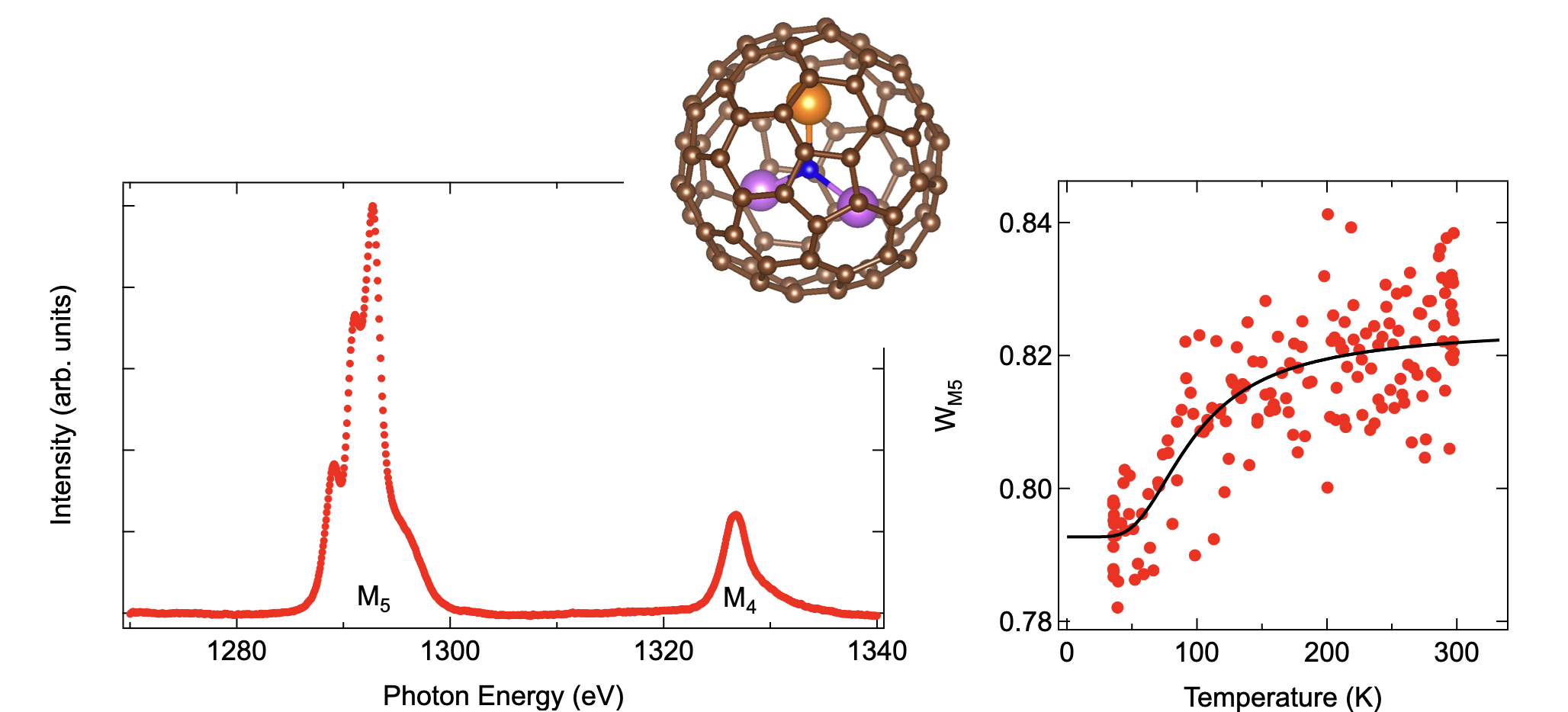
- Zoom (PNG, 396 KB)Figure: X-ray absorption spectrum at the Dy M4,5 edge of DySc2 N@C80 on a Pt(111) surface (left). The spectral weight of the M5 edge W M5 depends on the temperature and indicates the onset of endohedral rotation at about 90 K. The solid line is a thermodynamic model that describes the endohedral motion (right panel). The inset depicts one endohedral fullerene molecule with a diameter of 1.1 nm. Dysprosium yellow, nitrogen blue. Data R. Sagehashi et al.
The experiments were performed at the photoemission and atomic resolution laboratory (PEARL) bending magnet beamline at the Swiss Light Source. The project is a collaboration with the Institut für Festkörper- und Werkstoffforschung IFW in Dresden, the Chiba University, and the Paul Scherrer Institut in Villigen.
Highlighted Publications:
1. The Winner Takes It All: Carbon Supersedes Hexagonal Boron Nitride with Graphene on Transition Metals at High Temperatures, A. Hemmi et al., Small 18, 2205184 (2022)
2. X-ray absorption measurements at a bending magnet beamline with an Everhart-Thornley detector: A monolayer of Ho3 N@C80 on graphene, W. C. Lee et al., J. Vac. Sci. Technol. A 40, 053205 (2022)
3. Synthesis of a magnetic π-extended carbon nanosolenoid with Riemann surfaces, J. Wang et al., Nature Comm. 13, 1239 (2022)
Prof. Marc Janoschek - Correlated Quantum Matter
Our research is centered on genuine quantum phenomena in bulk materials that arise due to collective electronic behavior. These electronic correlations strongly couple spin, charge and lattice degrees of freedom resulting in emergent and rich low-energy physics. We study materials in which such collective quantum phenomena at the atomic-scale are borne out in exotic and functional macroscopic properties. We tune the underlying quantum interactions via external control parameters (pressure, field, strain, crystal chemistry) to understand the properties of quantum materials. For this purpose, we probe quantum matter with state-of-the-art large-scale neutron, photon and muon experiments.
New insights on the Kondo Lattice Problem
Effective low-energy models are a corner stone of solid state physics and have been instrumental in the qualitative understanding of collective electronic behavior in quantum materials. For example, the Kondo model—an iconic example of an effective low-energy model—was key to shedding light on the entanglement of localized and itinerant electronic degrees of freedom in strongly correlated metals. The interplay of these two opposing limits of electronic behavior is a reoccurring theme found at the heart of many quantum matter states ranging from unconventional superconductivity to correlated topological states of matter.
Despite the success of the Kondo lattice model, recent state-of-the-art electronic structure calculations indicate that quantitative and material-specific modelling of quantum matter states can only be achieved if high-energy degrees of freedom such as crystal field and spin-orbit interactions are included. Experimentally, however, it remained unclear how local high-energy degrees of freedom are incorporated into a collective electronic state. To overcome this challenge we employed resonant inelastic x-ray scattering (RIXS) on the prototypical Kondo lattice material CePd3 to elucidate the role of all relevant energy scales. We find that even spin-orbit excited states at 500 meV develop a pronounced momentum-dependence at low temperature signaling their incorporation into the underlying coherent metallic state (see Figure). Our study demonstrates how localized electronic degrees of freedom endow correlated metals with novel properties.
Emergent magnon Landau levels in a skyrmion lattice An electrically charged particle moving perpendicular to an applied magnetic field experiences a Lorentz force. In quantum mechanics, the resulting circular motion is quantized in discrete energy values known as Landau levels. In a two-dimensional electron gas, this quantum Hall effect is characterized by the formation of topological electronic bands with a finite Chern number. An analogy to the quantum Hall effect should also exist in the spin channel; for example, when the spin of a moving particle adiabatically follows the local magnetization of a topological spin texture, such as a skyrmion lattice, the inherent geometrical properties give rise to an emergent magnetic field, Bem , and an emergent Lorentz force. However, to date, probing the associated magnon Landau levels is a formidable experimental challenge as they are separated by energies on the order of 10 μeV. Using a novel state-of-the-art neutron spectroscopy method—so called MIEZE (modulated intensity with zero effort)— we resolve magnon Landau levels in the prototypical skyrmion lattice material MnSi for the first time.
Figure: Emergent Kondo coherence in CePd3 . At room temperature (top), the RIXS response is isotropic. The momentum dependence at low temperature (bottom) showcases the incorporation crystal field and spin-orbit states into the coherent metallic state.
Highlighted Publications:
1. Topological magnon band structure of emergent Landau levels in a skyrmion lattice, T. Weber, et al., Science 375, 6584 (2022)
2. Kondo quasiparticle dynamics observed by resonant inelastic x-ray scattering, M. C. Rahn, et al., Nat. Comm. 13, 6129 (2022)
Prof. Fabian Natterer - Quantum Matter
Our group investigates the properties of low-dimensional quantum materials. We explore how materials receive their properties from the interaction between individual atoms and molecules that we control with atomic precision. We also study how to tune a material’s electronic structure by the application of strain, doping, temperature, and magnetic fields. We spatially map the material’s electronic structure using customized scanning probe microscopy techniques, such as electron spin resonance, pump-probe spectroscopy, and fast quasiparticle interference imaging.
A versatile platform for graphene nanoribbon synthesis, electronic decoupling, and spin polarization We demonstrate how to obtain spin-polarized sensitivity, electronic decoupling, and efficient Ullman coupling on the same platform Cu3Au for the advanced study of open shell hydrocarbon and magnetic molecules. This work is a key component for our goal to realize a universal quantum sensor in which we intend to connect a molecular magnetometer to the tip of our scanning tunneling microscope. By mapping how the local environment modifies the magnetic structure of the molecule-on-tip using STM based electron spin resonance, we can identify the magnitude and coordinates of local moments with atomic resolution. In addition to sensing via electrical current, we also built an optical readout scheme for electro-luminescence measurements. Our sensor on-tip concept will illuminate the atomic-scale origin and properties of radicals, quantum matter by design, and noncolinear magnetic structures.
Electronic Structure Mapping of 2D Materials
We infer the band structure of two dimensional quantum materials with quasiparticle interference imaging (QPI). QPI works by measuring the point spectroscopy (local density of states) at every topographic location. To speed up this traditionally slow technique, we utilize compressed sensing and parallel spectroscopy. While the former enables the measurement of fewer locations, the latter speeds up the LDOS recording. In combination, we achieve three orders of magnitude faster mapping, which reduces a week-long measurement to few minutes. Our fast mapping enables previously inconceivable measurement protocols, such as studying a material near and across a critical point to which we tune it via a customized uniaxial strain cell. To make our measurements even more efficient, we use adaptive sparse samplingconcepts that enable prior-free measurements and provide the experimenter with immediate feedback to the electronic structure and quality of their measurements.
Figure: The combination of spin-polarization, electronic decoupling, and synthesis of carbon based molecules, enables the study of open-shell systems in their pristine form. The decoupling improves the spin-relaxation times with potential access to exploit the coherent properties of free radicals for advanced quantum sensing applications.
Highlighted Publications:
1. A. Cahlík et al., A versatile platform for graphene nanoribbon synthesis, electronic decoupling, and spin polarized measurements, Nanoscale Adv. (2023), doi:10.1039/D2NA00668E.1.
2. J. Oppliger et al., Adaptive Sparse Sampling for Quasiparticle Interference Imaging, MethodsX. 9, 101784 (2022).
Prof. Andreas Schilling - Phase Transitions, Materials and Applications
We are interested in selected topics in materials research, spanning the entire spectrum from searching new materials, their characterization, and corresponding applications. We have been particularly active in superconductivity, magnetism and thermodynamics. Our laboratory is equipped with modern furnaces for material synthesis, various 4 He/3 He cryostats and a dilution cryostat, all with superconducting magnets.
We are structuring thin superconducting films at the FIRST Center for Micro- and Nanoscience at ETHZ and are using them both for basic research and applications. While the physics of thin-film superconductors is a fascinating research topic by itself, corresponding nanostructures may serve as ultrafast single-photon detectors in the infrared, visible and X-ray range.
Universal spin-glass behavior in bulk LaNiO2, PrNiO2 and NdNiO2
Motivated by the recent discovery of superconductivity in doped infinite-layer nickelate thin films, we have synthesized and studied bulk samples of the so-called “parent compounds” RNiO2 (R = La, Pr, Nd). The synthesis of these compounds with a square-planar arrangement of the Ni-O atoms is achieved by topochemical reduction of RNiO3 grown under high oxygen pressure, to RNiO2 . In Fig. (a) we show evidence for the spin-glass behaviour of all RNiO2 samples provided by the presence of a distinct magnetic memory effect.
-
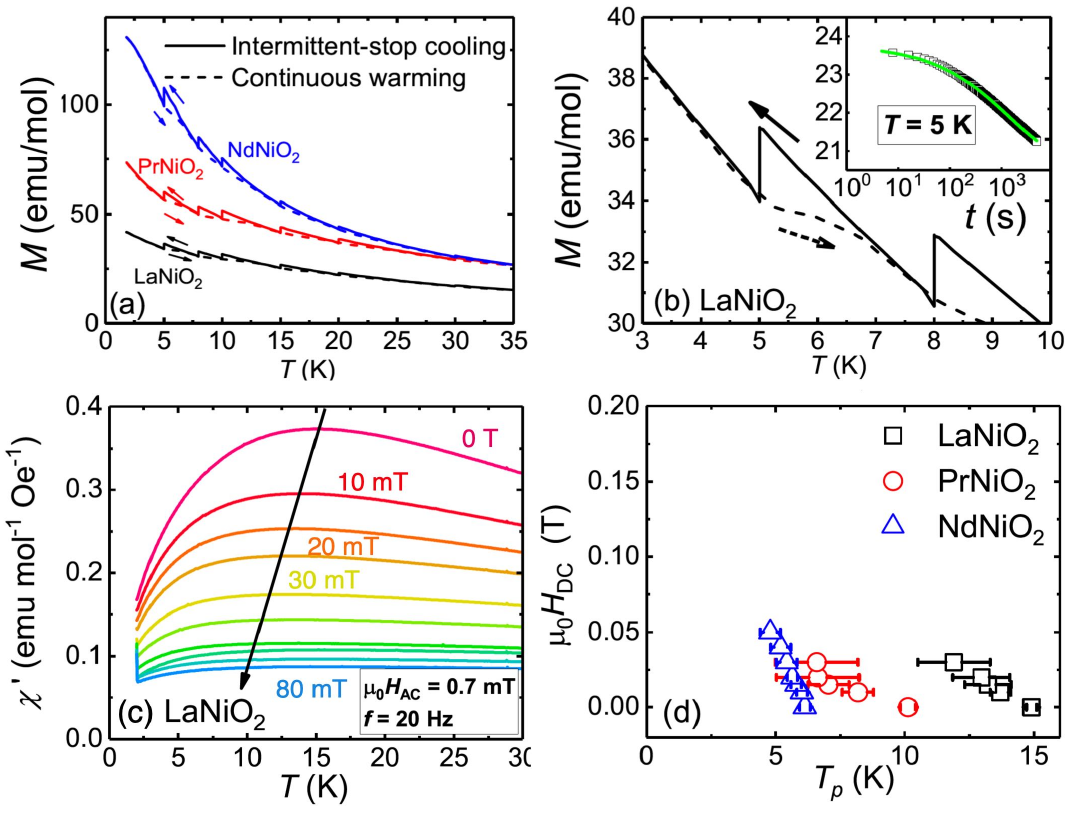
- Zoom (PNG, 383 KB)
- Figure: Magnetic memory effect [(a) and (b)], field dependence of the peak in the AC susceptibility of LaNiO2 (c), and resulting spin-freezing temperatures of RNiO2 (d).
Memory-effect measurements were performed using two different protocols, an “intermittent stop cooling process” (ISC-process) followed by a continuous warming process. At first, the sample is cooled in a magnetic field of 5 mT with intermittent stops at certain temperatures where the external field was switched off for 80 min and then switched back, followed by a further cooling down. At 1.8 K, the samples were warmed continuously to room temperature. The resulting magnetization data show distinct features at the previous stopping temperatures, and therefore reflect the magnetic history of the previous ISC-process. Furthermore, the magnetic-field dependence of the AC susceptibility χ (shown in Fig. (c) for LaNiO2 as an example), reveals that the peaks in χ are significantly suppressed with increasing DC magnetic field and may even vanish in moderate fields of the order of 1 T or even less. The corresponding peak temperatures, and along with them most likely the spin freezing temperatures, decrease rapidly as it is usually observed in spin glasses (Fig.(d)).
Based on all our collected data, we suggest that the universal spin glass behaviour in bulk RNiO2 compounds may be due to off-stoichiometric oxygen or even to an intrinsic magnetic frustration, rather than to impurities or weak crystallization. They exhibit a similarly slow spin dynamics as Pr4 Ni3 O8 that we had studied last year, although with an almost one-order-of magnitude lower spin-freezing temperature.
Highlighted Publications:
1. Universal spin-glass behavior in bulk LaNiO2 , PrNiO2 and NdNiO2, H. Lin et al., New. J. Phys. 24, 013022 (2022)
2. Suppression of the transition to superconductivity in crystal/glass high-entropy alloy nanocomposites, X. Zhang et al., Commun. Phys. 5, 282 (2022)
PD. Tatiana Latychevskaia (PSI) - Coherent Diffraction Imaging
We develop lens-less imaging methods towards high-resolution and three-dimensional imaging of nano-scaled objects, two-dimensional materials (graphene, TMDs, etc) and macromolecules. Coherent diffraction imaging (CDI) and holography are lens-less imaging techniques where the intensity of the wave diffracted by the sample is acquired by a detector in the far field. The phase distribution of the diffracted wave together with the sample structure is then reconstructed by applying numerical methods. Employing short wavelength radiation, such as electron or X-ray waves, in lens-less imaging techniques allows for imaging at atomic resolution.
Our current activities include:
1. Convergent beam electron diffraction (CBED) of two-dimensional materials (graphene) and nano-scaled objects such as individual macromolecules [1];
2. Light optical experiments for design and testing novel imaging techniques (holography, coherent diffraction imaging, ptychography, etc) [2];
3. Theoretical study and simulations of wave-matter interaction at atomic scale: effects of the probing wave coherence, multiple scattering, etc [3];
4. Developing novel imaging techniques for high-resolution (atomic-resolution) and three-dimensional reconstruction of samples’ structures from their diffraction patterns [4];
Figure: Atomic displacements in graphene with a single defect reconstructed by iterative phase retrieval from a convergent electron beam diffraction (CBED) pattern. (a) Positions of atoms in a lattice without relaxation, also shown as blue circles in (b) and (e). (b) Relaxed positions of atoms (red circles). (c) - (d) Difference between the atomic positions in the relaxed lattice and (c) lattice without relaxation, (d) the reconstructed lattice. (e) Reconstructed positions of the atoms around a defect (red circles). (f) Difference between the atomic positions in the lattice without relaxation and the reconstructed lattice [1].
Highlighted Publications:
1. Imaging defects in two-dimensional crystals by convergent beam electron diffraction, T. Latychevskaia, P. Huang, and K. S. Novoselov, Phys. Rev. B 105 184113 (2022), doi:10.1103/PhysRevB.105.184113
2. Fourier Transform Holography: A lensless imaging technique, its principles and applications, S. Mustafi, and T. Latychevskaia, Photonics 10 (2), 153 (2023) doi:10.3390/photonics10020153
3. Potentials of individual atoms by convergent beam electron diffraction, T. Latychevskaia et al., Carbon 201 244–250 (2023) doi:10.1016/j.carbon.2022.09.003
4. Low-dose shift- and rotation-invariant diffraction recognition imaging, T. Latychevskaia, and A. Kohli, Sci. Rep. 12 (1), 11202 (2022) doi:10.1038/s41598-022-15486-y
Table of contents
- Prof. Titus Neupert - Condensed matter theory
- Prof. Johan Chang - Superconductivity and Magnetism
- Prof. Marta Gibert - Oxide Interface Physics
- Prof. Thomas Greber - Low dimensional systems
- Prof. Marc Janoschek - Correlated Quantum Matter
- Prof. Fabian Natterer - Quantum Matter
- Prof. Andreas Schilling - Phase Transitions, Materials and Applications
- PD. Tatiana Latychevskaia (PSI) - Coherent Diffraction Imaging

